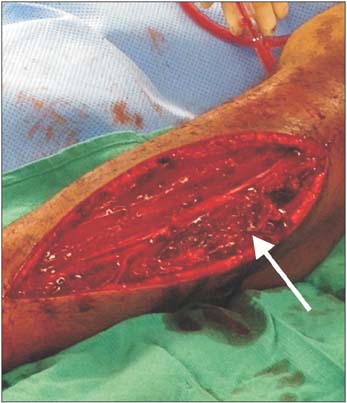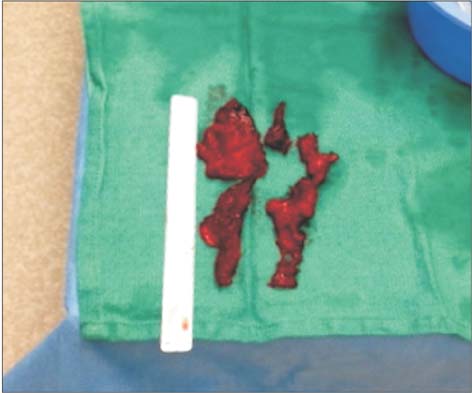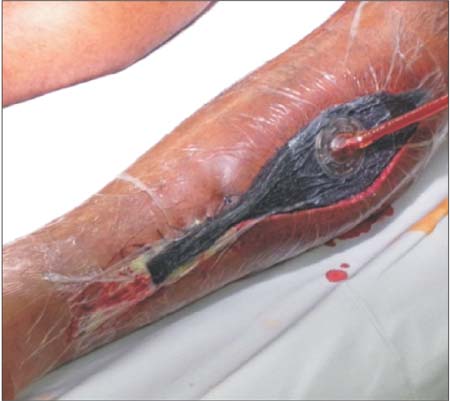Clin Orthop Surg.
2015 Dec;7(4):527-530. 10.4055/cios.2015.7.4.527.
Acute Compartment Syndrome after Non-Contact Peroneus Longus Muscle Rupture
- Affiliations
-
- 1Department of Orthopedic Surgery, Shoulder, Elbow and Knee Service, USC Keck Hospital, University of Southern California Keck School of Medicine, Los Angeles, CA, USA. yi.anthony.m@gmail.com
- KMID: 2360271
- DOI: http://doi.org/10.4055/cios.2015.7.4.527
Abstract
- This case demonstrates a rare variation in the pattern of injury and the presentation of acute lateral compartment syndrome of the leg. Although uncommon, lateral compartment syndrome of the leg after an ankle inversion leading to peroneus longus muscle rupture has been previously documented. This case was unusual because there was no overt ankle injury and the patient was able to continue physical activity, in spite of a significant rupture of the peroneus longus muscle that was determined later. This case highlights the necessary vigilance clinicians must maintain when assessing non-contact injuries in patients with possible compartment syndrome.
MeSH Terms
Figure
Reference
-
1. Tiwari A, Haq AI, Myint F, Hamilton G. Acute compartment syndromes. Br J Surg. 2002; 89(4):397–412.
Article2. Finkelstein JA, Hunter GA, Hu RW. Lower limb compartment syndrome: course after delayed fasciotomy. J Trauma. 1996; 40(3):342–344.3. Arciero RA, Shishido NS, Parr TJ. Acute anterolateral compartment syndrome secondary to rupture of the peroneus longus muscle. Am J Sports Med. 1984; 12(5):366–367.
Article4. Slabaugh M, Oldham J, Krause J. Acute isolated lateral leg compartment syndrome following a peroneus longus muscle tear. Orthopedics. 2008; 31(3):272.
Article5. Ashton LA, Jarman PG, Marel E. Peroneal compartment syndrome of non-traumatic origin: a case report. J Orthop Surg (Hong Kong). 2001; 9(2):67–69.
Article6. Rehman S, Joglekar SB. Acute isolated lateral compartment syndrome of the leg after a noncontact sports injury. Orthopedics. 2009; 32(7):523.
Article7. Olson SA, Glasgow RR. Acute compartment syndrome in lower extremity musculoskeletal trauma. J Am Acad Orthop Surg. 2005; 13(7):436–444.
Article8. Bhattacharyya T, Vrahas MS. The medical-legal aspects of compartment syndrome. J Bone Joint Surg Am. 2004; 86-A(4):864–868.
Article9. Hope MJ, McQueen MM. Acute compartment syndrome in the absence of fracture. J Orthop Trauma. 2004; 18(4):220–224.
Article10. Redfern D, Myerson M. The management of concomitant tears of the peroneus longus and brevis tendons. Foot Ankle Int. 2004; 25(10):695–707.
Article
- Full Text Links
- Actions
-
Cited
- CITED
-
- Close
- Share
- Similar articles
-
- Total Rupture of Peroneus Longus Tendon Through an Os Peroneum Fracture Treated by Tendon Transfer (A Case Report)
- Intramuscular Ganglion of the Peroneus Muscle Mimicking Peroneal Compartment Syndrome: A Case Report
- Fracture of the Os Peroneum with Rupture of the Peroneus Longus Tendon: A Case Report
- Surgical Treatment of Peroneus Longus Tendon Rupture after Ostectomy of Peroneus Tubercle of Calcaneus: A Case Report
- Fracture of Os Peroneum with Rupture of the Peroneus Longus Tendon: A Case Report




